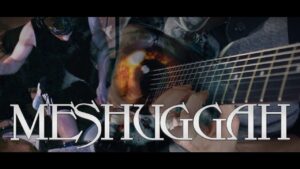Q&A: Photographer John Malley on Documenting the P…

SUBSCRIBE TONIGHT prime video

Dripping Decay
Metal’s history is always written on the ground floor. Academics only got into the mix in the 21st century. The best documentation comes from those who were there. Brian Lew and Harald Oimoen were there for the formative years of thrash; their collected work Murder In The Front Row still does brisk business in 2024. Peter Beste shot many of the now iconic images of Norwegian black metal. In the 80s, Cynthia Connolly documented the now legendary 80s DC hardcore scene.
Photographer John Malley is doing similar work in the Pacific Northwest. His lush, frenetic images have been featured in multiple publications (including Decibel), used by labels and bands, and more. Malley has a gift for shooting images that capture the vitality and close-knit nature of one of the country’s most active metal scenes. Malley talked to us about his work and chasing his passion later in life. You can follow John on Instagram to keep up with his new work.
Do you do photography full-time? Where did you learn photography?
I do several things outside of photography. One of my kids has challenges requiring my wife and me to be home. I am largely self-taught and got my first camera as a graduation present (from high school) in 1989. My Mom loved photography. I learned photography at her feet. She did a lot of landscape and portrait photography because she loved it. It (photography) was always part of what I was doing, whether in grad school in political science or working as a public teacher in Milwaukee schools.
Were you already a metalhead when you got your first camera?
I grew up with Hendrix, Blue Cheer, and Led Zeppelin. I was born into heavier rock, and I transitioned into metal. My uncle got me AC/DC’s For Those About To Rock the year it came out. I just went more extreme as I got older, but I’ve been a metalhead since day one. I grew up in Maine before the Internet; we were on the outskirts. A friend turned me on to Death when they first came out. When I started working at a college radio station, we got records from everywhere, and I dove in.

How did you go from learning your craft independently to where you are now documenting a scene?
I did landscapes and family stuff when I was younger and occasionally got called for a wedding. I never considered shooting music until I moved to Seattle eight years ago. Concert photography is relatively new. I shot my first gig (Lee Ranaldo of Sonic Youth fame) on my phone, not with a camera. Lee found the photos online and started sending me DMs. I’d never thought about concert photography until Lee sent me those messages. That’s what got the ball rolling. I just wanted to take pictures of bands I liked locally. I love what’s going on here.
So it seems like this was almost a happy accident? This has become a crux of your life in middle age.
When I decided to become more of an in-home father, I had a bit of an identity crisis. I was thinking, “Who am I, and what am I going to do?” When I grew up in Maine, there wasn’t ever a scene. Seattle seemed like a mythical place. When I finally arrived, I thought I would attend every show I could. I’ve seen Mudhoney about 30 times in six years. I quickly learned that there is an incredible current scene.

I grew up outside of Washington, DC. I don’t know if you’ve ever seen Lucian Perkins or Cynthia Connolly’s early work documenting 80s hardcore. Your work includes a lot of similar scene documentation.
Our amazing community here works incredibly hard and supports each other. I haven’t seen something this collaborative in my entire life. What we have going on here is mind-blowing and diverse. We have 40 or 50 bands in Seattle and Tacoma that blow my mind. I think there is something about this community that makes people feel like they can take a chance and be supported.

So you are at these shows and clearly of an older generation. Has anyone confused you for someone’s Dad?
I am like the crazy uncle up here (laughs). Given my background in education teaching in universities and middle schools, I firmly believe youth is where hope lies. Old people get stuck in their past. I’ve always gravitated towards the young. I’m not trying to teach anyone now. Sure, I’ve received some shit about being the old guy at shows, but I can give it as good as I get it. Seattle is an incredibly inclusive metal scene, and age is one of many dimensions. There is a lot of acceptance in this scene.
Metal is also one of those genres, like blues, that you can contribute regardless of age if you still bring it.
There is a lot of respect in this region for what came before. People still talk about Tad in hushed tones. A lot of older people come to shows. We might be standing back and using a telephoto lens, but we are there. And we are here to help and participate.

How do you set up a good photo?
I’m interested in trying to get interactions with the band and crowd. I almost always look at the stage sideways. In my head, I think about the crowd’s actions and how the band interacts with the crowd. I’m also a musician – not a good one, but a musician – but I know when solos are coming up. I’ll know to move over before a solo kicks in. I work well with certain bands and know I can capture them the way they want to be captured. It’s all about interaction and energy.
You work in black-and-white a lot. What do you like about that format?
I grew up loving black-and-white concert photography. Charles Peterson documented the Sub Pop scene up here. Something about his use of black-and-white boiled things down to the essentials. Too much color can lose the centrality of the subject. Black-and-white helps simplify the image and brings the subject into focus. I’ve just always loved it, and I gravitated to it.

Has anyone talked to you about collecting your images in a book?
I’ve had a few people bring it up loosely. It’s something I’d like to do at some point. I could see it happening. I’ve talked to a few people about a coffee table book. I’m not that great at marketing myself. I’d rather just spend my time shooting the hell out of shows.
What advice do you have for someone wanting to pursue a passion later in life?
You must be willing to let go of who you thought you should be. I was in education for almost 20 years and considered that my identity. You have to be comfortable with some uncertainty. I don’t think you are ever too old to take a chance on a passion. I spent much of my life wishing I had done certain things. It’s not a good way to live. To finally do something that is a passion was scary as hell but is now incredibly rewarding.
SUBSCRIBE TONIGHT prime video
Source link








